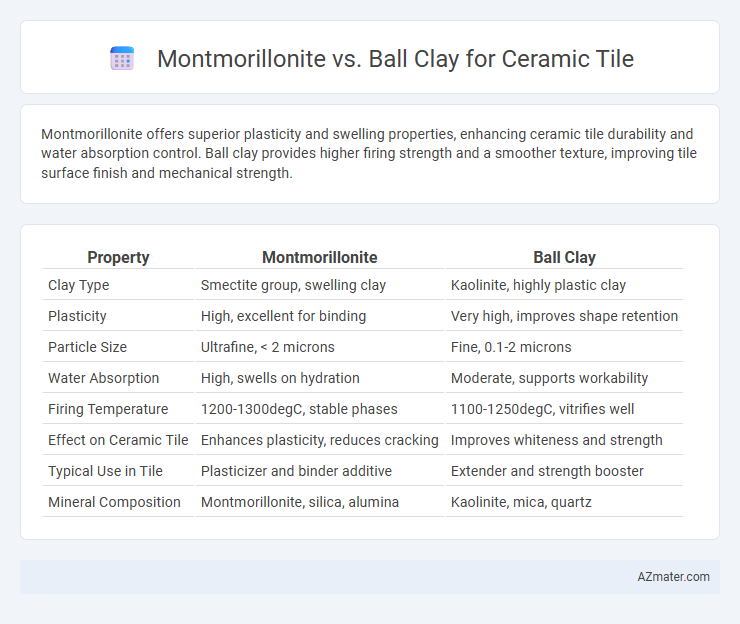Montmorillonite offers superior plasticity and swelling properties, enhancing ceramic tile durability and water absorption control. Ball clay provides higher firing strength and a smoother texture, improving tile surface finish and mechanical strength.
Table of Comparison
| Property | Montmorillonite | Ball Clay |
|---|---|---|
| Clay Type | Smectite group, swelling clay | Kaolinite, highly plastic clay |
| Plasticity | High, excellent for binding | Very high, improves shape retention |
| Particle Size | Ultrafine, < 2 microns | Fine, 0.1-2 microns |
| Water Absorption | High, swells on hydration | Moderate, supports workability |
| Firing Temperature | 1200-1300degC, stable phases | 1100-1250degC, vitrifies well |
| Effect on Ceramic Tile | Enhances plasticity, reduces cracking | Improves whiteness and strength |
| Typical Use in Tile | Plasticizer and binder additive | Extender and strength booster |
| Mineral Composition | Montmorillonite, silica, alumina | Kaolinite, mica, quartz |
Introduction to Montmorillonite and Ball Clay
Montmorillonite is a type of smectite clay mineral known for its exceptional swelling properties and high cation exchange capacity, making it valuable in ceramic tile production for enhancing plasticity and water absorption control. Ball clay, predominantly composed of kaolinite, mica, and quartz, is prized for its fine particle size and strong plasticity, providing workability and strength to ceramic tile bodies. Both clays significantly influence the rheological behavior and final mechanical properties of ceramic tiles, with montmorillonite improving suspension stability and ball clay contributing to fired tile hardness and durability.
Chemical Composition Comparison
Montmorillonite primarily consists of hydrated sodium calcium aluminum magnesium silicate, featuring a high cation exchange capacity and swelling properties due to its layered structure. Ball clay is mainly composed of kaolinite (aluminum silicate hydroxide), with higher levels of silica, alumina, and organic matter, contributing to its plasticity and smooth texture. The chemical composition differences influence ceramic tile performance, where montmorillonite's swelling can improve water absorption, while ball clay enhances workability and fired strength.
Physical Properties of Each Clay
Montmorillonite exhibits high plasticity, excellent swelling capacity, and low density, making it valuable for enhancing the flexibility and thermal shock resistance of ceramic tiles. Ball Clay has a finer particle size, higher plasticity, and greater dry strength, contributing to improved workability and durability in ceramic tile production. The distinct particle morphology and mineral composition of Montmorillonite versus Ball Clay directly influence their bending strength, shrinkage rate, and water absorption properties in the final ceramic product.
Origins and Geological Formation
Montmorillonite originates primarily from the weathering of volcanic ash in sedimentary basins, forming clay deposits rich in swelling properties and high plasticity, predominantly found in regions like the United States and France. Ball clay forms from the sedimentation of fine-grained kaolinite, mica, and quartz particles in ancient river deltas and lagoons, exhibiting high purity and plasticity, with significant deposits in the UK, the United States, and Brazil. The geological formation of montmorillonite involves alteration of volcanic materials through hydrothermal processes, while ball clay develops through the natural settling of fine sediments under low-energy aquatic environments.
Plasticity and Workability in Tile Manufacturing
Montmorillonite offers high plasticity, enabling superior shaping and molding in ceramic tile manufacturing compared to Ball Clay, which provides moderate plasticity but contributes better to the tile's strength and hardness. The swelling capacity of Montmorillonite enhances workability by improving the clay's softness and flexibility during shaping processes. Ball Clay's finer particle size ensures a smoother surface finish, but Montmorillonite's plasticity is critical for intricate tile designs requiring detailed work.
Influence on Tile Firing Behavior
Montmorillonite enhances ceramic tile firing behavior by providing superior plasticity and water retention, which improves tile workability and reduces cracking during drying and firing. Ball clay contributes high plasticity and fine particle size but tends to increase shrinkage and risk of warping if not properly balanced. Combining montmorillonite with ball clay optimizes firing behavior by stabilizing shrinkage and promoting uniform densification, resulting in stronger and more durable ceramic tiles.
Effects on Finished Tile Strength and Durability
Montmorillonite enhances ceramic tile strength and durability due to its high plasticity and swelling properties, which improve particle bonding and reduce porosity during firing. Ball clay contributes to tile workability and green strength but has lower refractory qualities, resulting in finished tiles that may be less resistant to mechanical stress and thermal shock compared to those made with montmorillonite. Optimizing the ratio of montmorillonite to ball clay can significantly increase the fired tile's flexural strength and resistance to cracking over time.
Common Applications in Ceramic Tile Industry
Montmorillonite is widely used in ceramic tile production for its excellent plasticity and swelling properties, enhancing the workability and texture of the clay body. Ball clay, known for its fine particle size and high plasticity, contributes to the strength and smooth surface finish of ceramic tiles, making it ideal for wall and floor applications. Both clays are integral in formulating balanced raw materials that optimize tile durability, firing temperature, and water absorption rates.
Environmental and Cost Considerations
Montmorillonite offers superior plasticity and swelling capacity, improving ceramic tile workability but may require higher energy consumption during processing due to moisture content, influencing environmental impact and cost. Ball clay provides consistent particle size and firing performance, reducing waste and lowering production costs, yet its mining may pose sustainability challenges. Evaluating the balance between Montmorillonite's enhanced shaping properties and Ball clay's cost-effective maintainability is crucial for sustainable ceramic tile manufacturing.
Choosing the Right Clay for Specific Tile Needs
Montmorillonite offers exceptional plasticity and shrink-swell capacity, making it ideal for ceramic tiles that require flexibility and durability during firing. Ball clay provides fine particle size and high dry strength, enhancing tile whiteness and smoothness, which suits tiles demanding aesthetic precision. Selecting between Montmorillonite and Ball clay depends on desired tile properties such as mechanical strength, firing behavior, and surface finish requirements.

Infographic: Montmorillonite vs Ball Clay for Ceramic Tile
 azmater.com
azmater.com